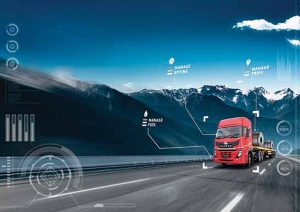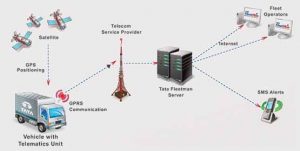Going beyond track and trace, telematics in commercial vehicles is coming to associate with safe driving.
Commercial vehicle operators are no strangers to telematics. The days when the system was new and felt like it was from Mars with unique predatory qualities is behind us. Quite common in trucks and buses the world over, and in van fleets too, telematics, as a positive force, is leading to a safe drive. Offered as a factory fitment, or as a dealer fitment, and even as an aftermarket fitment, telematics in India is growing at a rapid pace in India. Expected to bridge the USD 113.7 million mark this year, with a CAGR of 22.8 per cent during the period 2013-2018, the telematics market in India has a good deal of its growth coming from the application in commercial vehicles. Typical application areas in commercial vehicles include passenger safety and security, customer relationship management, business services such as fleet management and tracking, and private services such as navigation support to passengers. With greater value chain coverage the key growth driver of telematics in the commercial vehicle industry, telematics is also enabling OEMs to differentiate themselves and capture opportunities beyond vehicle sales. Supporting activities like remote diagnostics, load detection and monitoring, performance analysis, order management and tacho management, telematics has come to touch all areas of the CV industry, may it be new vehicles sales, financial services, rental, spare parts sale, service and repair, fleet management and fleet operation.
Used to track and trace rather than anything else, telematics is beginning to be looked upon as a technology that can do more. This is especially happening post the migration to BSIV where many CV OEMs are offering telematics as a standard fitment in some segments. For applications like a school bus, staff bus, etc., the application of telematics is mandatory. Where it is not mandatory is where the real change is underway. And, this is said to be linked to the rising awareness that telematics can help improve safety. Fleets are becoming aware of the positives of lower accident rates, and how they make the most important factor in employee safety. A marked shift in the motives for buying into the technology is apparent thus. A big part of this shift could be accounted for the rising awareness at various companies in the area of cement, FMCG, auto, oil and gas, etc., which are compelling their logistics partners to invest in telematics not just as a track and trace tool, but as the one that will improve safety and reduce risks. Driven by the need to implement the global safety parameters in India without any dilution as part of the operating protocol, and by the entry of professional international fleets, telematics as a means to elevate safety and cut down risks is also fast finding use in relatively new areas like e-commerce and agricultural supply chain. Telematics is rising beyond refrigerated trucks as far as the agricultural supply chain bit is concerned, and that is a clear sign that telematics is beginning to tread far beyond track and trace.
Finding greater use in lighter CVs and vans in India unlike a few years back when telematics was looked upon as an intrusive system fit to be used on heavy and hazardous goods vehicles only, the day is not far when exponential growth will touch the industry as the electronic content in vehicles grows. The good part about the use of telematics as a safety and risk aversion technology is how it gets the drivers to not drive at excessively high speeds. With many fleets engaging with specialist clients who need trucks that are specifically out-fitted with special bodies to serve specific requirements, the risk of accidents or damage can lead to considerable economic damage. The use of telematics to cut accidents and the associated economic loss is forming the basis for the rising application of telematics in CVs. Large fleets in India are beginning to use data from telematics devices to address drivers’ training requirements. Targeted driver training is becoming popular with large companies in particular. Acknowledging the benefits, some large fleets have invested in driver training centers. There are CV makers who have already invested or are investing in driver training centers. They are keen to use telematics to access data, gauge the performance and help drivers to improve their driving skills.
Insurance is another area where telematics could be used as an incentive to elevate driving safety and operational safety of commercial vehicles. Insurance costs have steeply risen in the recent times, and are continuing to grow. Telematics could find a way of lowering the associated costs, premium costs and elevate safety. In many markets of the world, the possibility of lowering insurance costs through telematics-linked policies is proving to be attractive with young fleet operators and owner-operators. A significant rise in third-party insurance premium for commercial vehicles had the Indian transport associations up in arms. Telematics-linked policies are certain to provide the much-needed relief as far as the premium costs are concerned. It is interesting to know that large fleets are starting to use telematics to keep track of how their managers are monitoring driver behaviour, and if they are providing the driver’s feedback to make sure they make behavioural changes and drive safely and efficiently. From being viewed as a spy in the cab, the perception about telematics is fast changing. Telematics is coming to be looked upon as an enabler. Drivers are coming to realise the benefit of telematics to help them be safe and drive safely. They are also coming to acknowledge the fact that they can communicate as well as turn their vehicle into a mobile workstation.






















